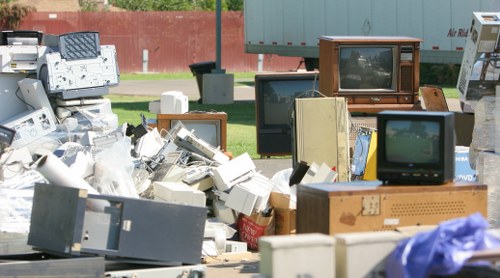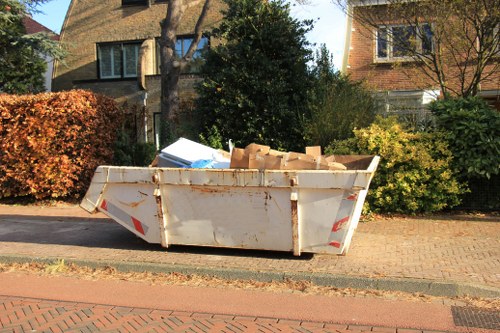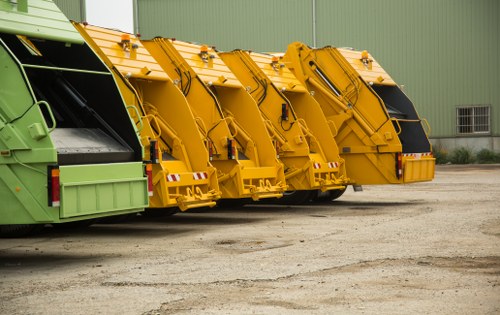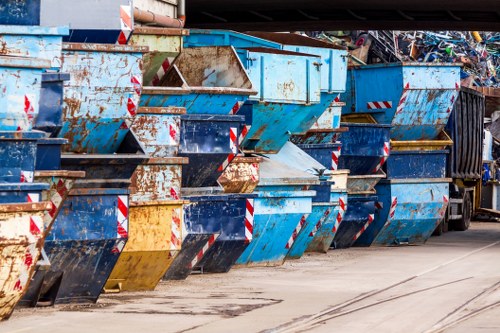Sofa Removal in Waste Recycling

Understanding Sofa Removal
Sofa removal is a crucial step in effective waste recycling. As one of the most common pieces of furniture in households, sofas often reach the end of their lifespan due to wear and tear, changes in interior design preferences, or the need for renovation. Proper removal ensures that the materials are handled responsibly, reducing environmental impact and promoting sustainability.
Engaging in professional sofa disposal services not only alleviates the burden of transporting heavy furniture but also guarantees that your old sofa is processed in an eco-friendly manner. These services are equipped to handle various types of sofas, ensuring that each component is sorted and recycled according to industry standards.
Moreover, responsible sofa removal contributes to reducing landfill waste, conserving natural resources, and minimizing the carbon footprint associated with furniture production. By choosing sustainable disposal methods, consumers play a pivotal role in fostering a greener environment.

The Importance of Waste Recycling
Waste recycling is pivotal in today’s world where environmental concerns are at the forefront. By recycling sofas, we can significantly decrease the volume of waste that ends up in landfills. This not only saves space but also reduces the environmental degradation caused by improper waste disposal.
Recycling involves breaking down old sofas into their constituent materials, such as wood, metal, and fabric, which can then be reused in the manufacturing of new products. This process conserves natural resources, as it reduces the need for virgin materials, and lowers energy consumption compared to producing goods from scratch.
In addition to environmental benefits, waste recycling supports the economy by creating jobs in the recycling and manufacturing sectors. It encourages innovation in sustainable practices and promotes the development of eco-friendly products, aligning with global efforts to combat climate change.

Steps Involved in Sofa Removal
1. Assessment and Planning
The initial step in sofa removal involves assessing the condition of the furniture and determining the most efficient disposal method. Professionals evaluate whether the sofa can be refurbished, donated, or needs to be broken down for recycling. This assessment ensures that each component is handled appropriately, optimizing the recycling process.
2. Safe Transportation
Once the removal plan is in place, the sofa is carefully transported from its location to the recycling facility. This step requires specialized equipment to handle large and heavy furniture, preventing damage to both the sofa and the property from which it is removed.
3. Recycling and Processing
At the recycling facility, the sofa is disassembled into its basic materials. Wood frames, metal springs, foam padding, and fabric coverings are separated and processed for reuse. Advanced machinery and skilled labor ensure that each material is efficiently recycled, reducing waste and promoting sustainability.

Benefits of Professional Sofa Removal Services
Hiring professional sofa removal services offers numerous advantages. It ensures that the removal process is handled efficiently and safely, minimizing the risk of injury or property damage. Professionals are trained to disassemble and transport sofas with care, preserving the integrity of both the furniture and your living space.
Additionally, these services provide convenience by managing all aspects of sofa disposal, from collection to recycling. This eliminates the stress and effort involved in coordinating the removal, allowing you to focus on other priorities.
Furthermore, professional services often adhere to strict environmental standards, ensuring that your old sofa is disposed of responsibly. They have established partnerships with recycling facilities, guaranteeing that materials are processed in a manner that aligns with sustainability goals.

Environmental Impact of Sofa Recycling
Recycling sofas plays a significant role in mitigating environmental impact. By diverting furniture from landfills, we reduce the release of harmful chemicals and greenhouse gases associated with decomposition and waste management. This contributes to cleaner air and soil, enhancing overall ecosystem health.
Moreover, recycling materials from sofas lessens the demand for new raw materials, preserving natural habitats and biodiversity. It also conserves energy, as producing recycled materials typically requires less energy compared to manufacturing new ones from scratch.
In addition to these environmental benefits, sofa recycling fosters a culture of sustainability. It raises awareness about the importance of responsible consumption and waste management, encouraging individuals and businesses to adopt eco-friendly practices in their daily lives.
How to Choose a Reliable Sofa Removal Service
Credentials and Certifications
When selecting a sofa removal service, it’s essential to verify their credentials and certifications. Reputable companies are often certified by environmental organizations, ensuring they adhere to industry standards for waste recycling and disposal.
Customer Reviews and Reputation
Examining customer reviews and the company’s reputation can provide insights into the quality of their services. Positive feedback and a strong track record indicate reliability and customer satisfaction, giving you confidence in their ability to handle your sofa removal efficiently.
Pricing and Transparency
Transparent pricing structures are indicative of trustworthy services. Ensure that the company provides clear estimates without hidden fees, allowing you to make an informed decision based on your budget and needs.
DIY Sofa Disposal vs. Professional Removal
While some may consider DIY sofa disposal to save money, it often proves to be more challenging and less environmentally friendly. Without the proper tools and knowledge, disassembling and transporting a sofa can lead to damage or injury. Additionally, DIY methods may not ensure that materials are recycled appropriately, contributing to environmental harm.
In contrast, professional removal services offer expertise and resources that guarantee safe and responsible disposal. They manage every aspect of the process, from collection to recycling, providing peace of mind and ensuring that your old sofa is handled sustainably.
Moreover, professional services can often streamline the process, completing the removal quickly and efficiently, whereas DIY efforts may be time-consuming and cumbersome.
Cost Considerations in Sofa Removal
Factors Influencing Pricing
The cost of sofa removal can vary based on several factors, including the size and weight of the sofa, the distance to the recycling facility, and the complexity of the removal process. Additional services, such as disassembly or same-day removal, may also affect pricing.
Comparing Service Providers
To ensure you receive value for your money, compare quotes from multiple sofa removal services. Assess the range of services offered, their environmental practices, and customer feedback to make a well-informed decision.
Budget-Friendly Options
Many professional services offer competitive pricing and discounts, making sofa removal affordable. Additionally, some companies may provide free estimates or promotional offers, allowing you to manage costs effectively while ensuring responsible disposal.
Legal and Environmental Regulations
Compliance with legal and environmental regulations is paramount in sofa removal and waste recycling. Governments often mandate specific guidelines for the disposal of large furniture to ensure that materials are recycled appropriately and hazardous substances are handled safely.
Professional removal services are well-versed in these regulations, ensuring that your sofa is disposed of in accordance with the law. This adherence not only protects the environment but also shields you from potential legal repercussions associated with improper disposal.
Staying informed about local and national regulations regarding waste management can help you make responsible choices and support broader environmental initiatives aimed at sustainability.
Innovations in Sofa Recycling
Advanced Recycling Technologies
The recycling industry is continually evolving, with innovations that enhance the efficiency and effectiveness of furniture recycling. Advanced technologies enable the separation and processing of materials more accurately, ensuring higher quality recycled products.
Upcycling Initiatives
Upcycling transforms old sofas into new, functional items, extending the lifespan of materials and reducing waste. Creative approaches to upcycling not only minimize environmental impact but also offer unique design opportunities for consumers.
Circular Economy Practices
The concept of a circular economy emphasizes the continual use of resources through recycling and upcycling. By integrating circular economy practices, sofa removal and recycling contribute to a sustainable model where materials are reused, reducing the need for new production and minimizing environmental stress.
Community and Social Impact
Sofa removal and recycling have significant community and social implications. By participating in responsible waste management, communities can foster a sense of collective responsibility towards the environment. Educational initiatives and community programs can further promote sustainable practices and encourage participation in recycling efforts.
Additionally, recycling old sofas can support local charities and non-profit organizations. Donated furniture can benefit those in need, providing essential home furnishings while reducing waste.
Engaging in community-driven recycling programs also strengthens social bonds and encourages collaboration towards common environmental goals, creating a more cohesive and environmentally conscious society.
Future Trends in Sofa Waste Management
Sustainable Material Innovations
The future of sofa waste management lies in the development of sustainable materials that are easier to recycle and have a reduced environmental footprint. Innovations in fabric, foam, and frame materials can simplify the recycling process and enhance the longevity of furniture.
Smart Furniture Design
Designing sofas with recycling in mind can streamline the waste management process. Features such as modular components, easily detachable parts, and minimal use of mixed materials facilitate efficient disassembly and material separation, making recycling more effective.
Enhanced Recycling Infrastructure
Investing in robust recycling infrastructure, including advanced facilities and logistics systems, is essential for managing sofa waste sustainably. Improved infrastructure can increase recycling capacity, reduce processing times, and ensure that recycled materials are seamlessly reintegrated into the manufacturing cycle.
Conclusion
Sofa removal in waste recycling is a vital component of sustainable living. By responsibly disposing of and recycling old sofas, we contribute to environmental preservation, resource conservation, and the reduction of landfill waste. Engaging professional removal services ensures that this process is handled efficiently and in compliance with environmental regulations.
As society continues to prioritize sustainability, innovations in recycling technologies and circular economy practices will further enhance the efficacy of sofa waste management. Communities and individuals alike play a crucial role in supporting these initiatives, fostering a culture of responsible consumption and waste reduction.
Embracing sofa recycling not only benefits the environment but also supports economic growth and social well-being. By making informed choices and investing in sustainable disposal methods, we pave the way for a greener, more resilient future.
Contact us today to arrange your sofa removal and join the movement towards sustainable waste recycling.Book your service now and make a positive impact on the environment.